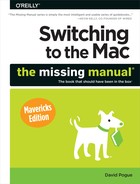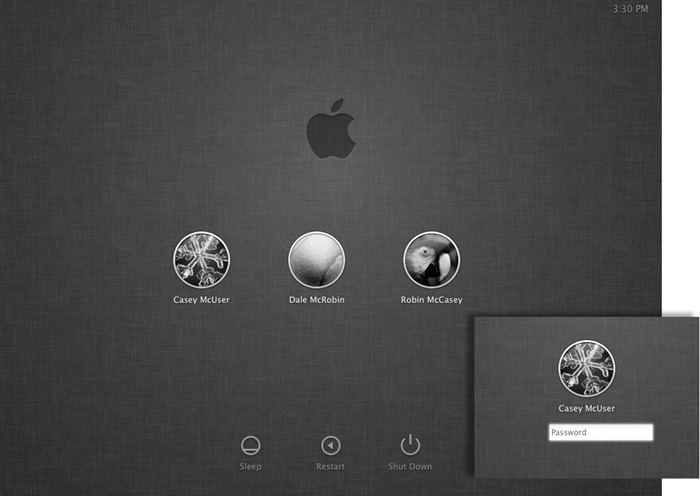When you first turn on a Mac running OS X 10.9, an Apple logo greets you, soon followed by an animated, rotating “Please wait” gear cursor—and then you’re in. No progress bar, no red tape.
What happens next depends on whether you’re the Mac’s sole proprietor or have to share it with other people in an office, school, or household.
If it’s your own Mac, and you’ve already been through the setup process described in Appendix A, no big deal. You arrive at the OS X desktop.
If it’s a shared Mac, you may encounter the newly redesigned Login screen, shown in Figure 2-1. It’s like a portrait gallery, set against a handsome piece of dark gray linen. Click your icon.
If the Mac asks for your password, type it and then click Log In (or press Return). You arrive at the desktop.
Chapter 14 offers much more on this business of user accounts and logging in.
Note
In certain especially paranoid workplaces, you may not see the rogue’s gallery shown in Figure 2-1. You may just get two text boxes, where you’re supposed to type in your name and password. Without even the icons of known account holders, an evil hacker’s job is that much more difficult.
Figure 2-1. On Macs used by multiple people, this is one of the first things you see upon turning on the computer. Click your name. (If the list is long, you may have to swipe the trackpad to find your name—or just type its first few letters.) Inset: At this point, you’re asked to type in your password. Type it, and then click Log In (or press Return). If you type the wrong password, the box vibrates, shaking its little dialog-box head, suggesting that you guess again.
The desktop is the shimmering, three-dimensional OS X landscape shown in Figure 2-2. On a new Mac, it’s covered by a photo of a spectacular surfing wave; the name “Mavericks” is, after all, taken from a surfing beach in California. (If you upgraded from an earlier version of OS X, you keep whatever desktop picture you had before.)
If you’ve ever used a computer before, most of the objects on your screen are nothing more than updated versions of familiar elements. Here’s a quick tour.
Note
If your desktop looks even emptier than this—no menus, no icons, almost nothing on the Dock—then somebody in charge of your Mac has turned on Simple Finder mode for you. Details on Use Simple Finder.
In Windows, disk icons remain safely caged in the My Computer window; they don’t appear on the desktop automatically. The Mac starts out the same way; to find the icons of disks you’ve inserted, you have to look in the Sidebar (Zoom Button) or the Computer window (Go→Computer).
If you’d like to save yourself that burrowing, though, you can choose Finder→Preferences, click General, and turn on the checkboxes of the disks whose icons you want on the desktop: hard disks, external disks, iPods, and so on.
This row of translucent, almost photographic icons is a launcher for the programs, files, folders, and disks you use often—and an indicator to let you know which programs are already open. They appear to rest on a sheet of transparent smoked glass.
Because the Dock is such a critical component of OS X, Apple has decked it out with enough customization controls to keep you busy experimenting for months. You can change its size, move it to the sides of your screen, hide it entirely, and so on. The Dock begins a complete discussion of using and understanding the Dock.
Figure 2-2. The OS X landscape looks like a more futuristic version of the operating systems you know and love. This is just a starting point, however. You can dress it up with a different background picture, adjust your windows in a million ways, and, of course, fill the Dock with only the programs, disks, folders, and files you need.
The ![]() menu houses important Mac-wide commands like Sleep, Restart, and Shut Down. They’re always available, no matter which program you’re using.
menu houses important Mac-wide commands like Sleep, Restart, and Shut Down. They’re always available, no matter which program you’re using.
The first menu in every program, in boldface, tells you at a glance what program you’re in. The commands in this Application menu include About (which tells you what version of the program you’re using), Preferences, Quit, and others like Hide Others and Show All (which help you control window clutter).
The File and Edit menus come next, exactly as in Windows. The last menu is almost always Help. It opens a miniature Web browser that lets you search the online Mac help files for explanatory text.


